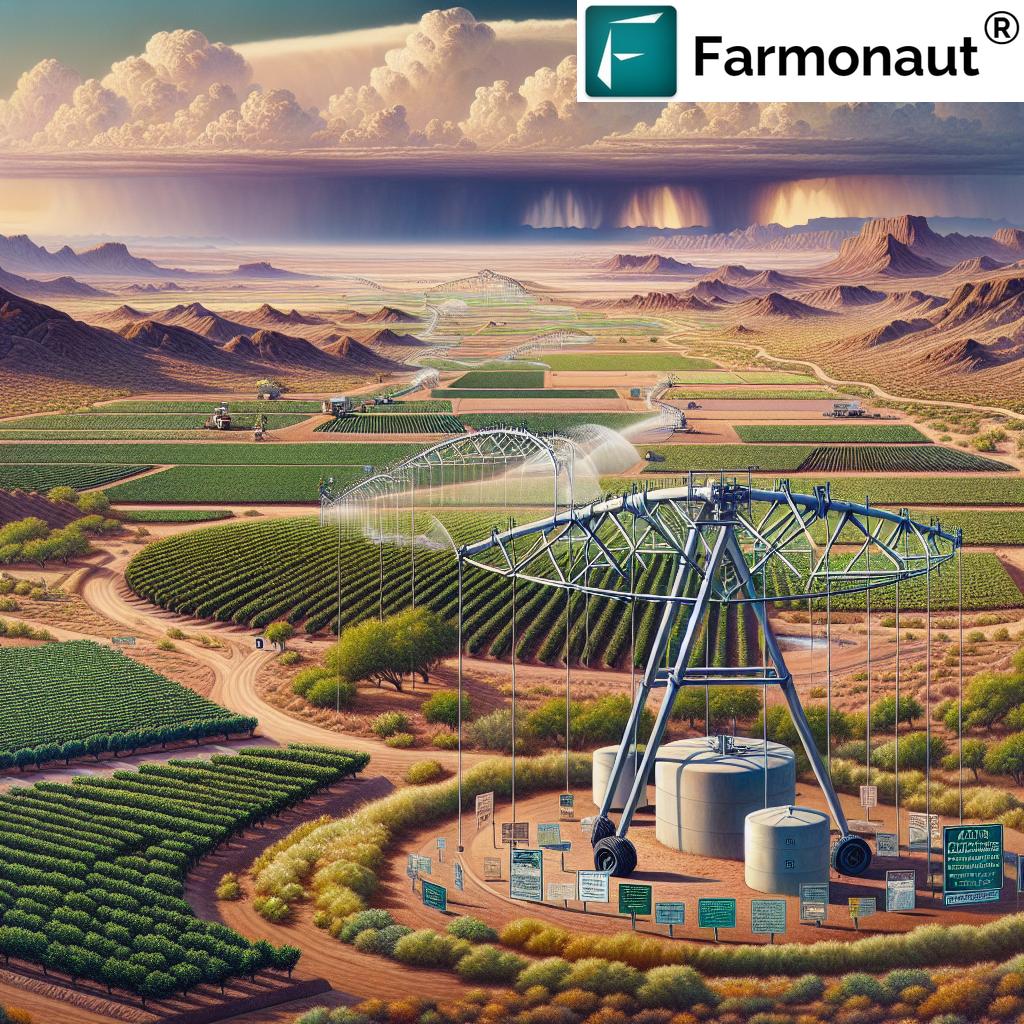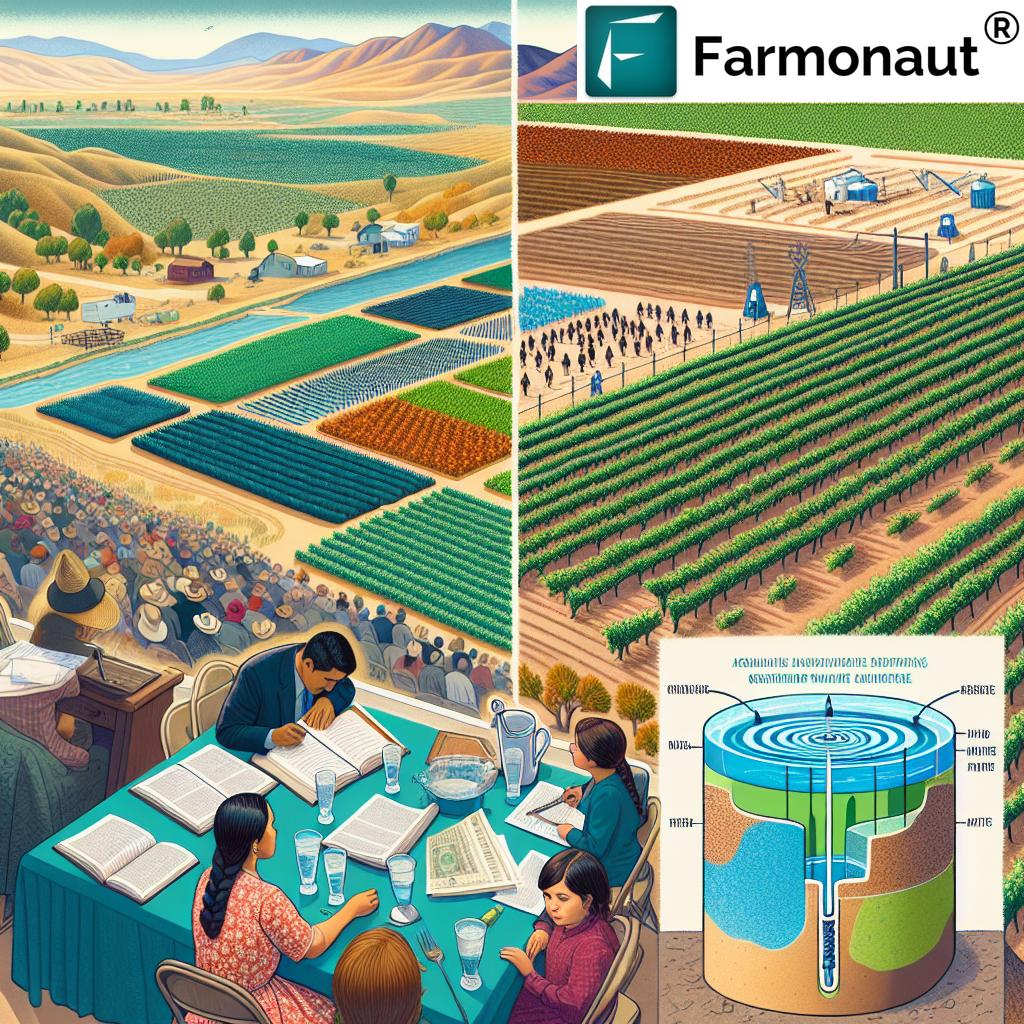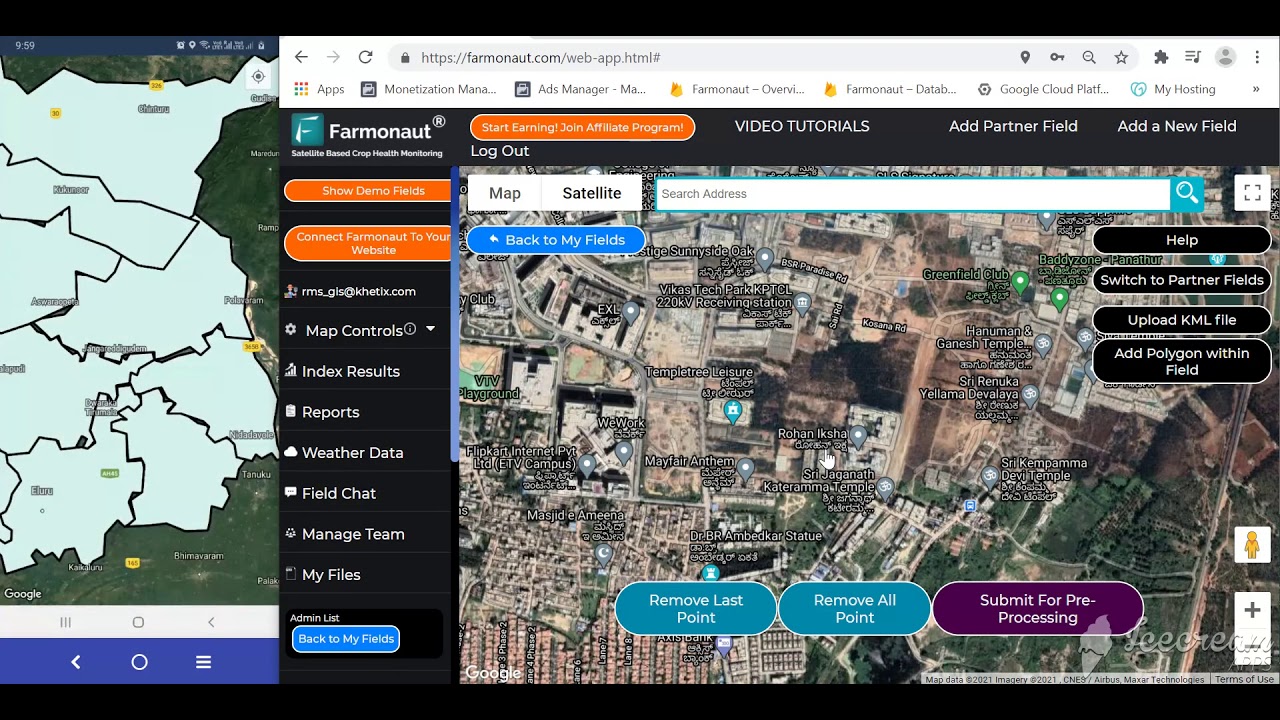Sustainable Groundwater Management in Arizona: Balancing Agricultural Needs and Aquifer Conservation in Willcox Basin
“Arizona’s Willcox basin aims to reduce groundwater overdraft by 50% over 50 years to combat aquifer depletion.”
In the heart of southeastern Arizona, the Willcox basin faces a critical juncture in its water management journey. As we delve into the complexities of balancing agricultural needs with long-term water conservation, we find ourselves at the forefront of a challenging yet crucial endeavor. The Arizona Department of Water Resources has proposed an ambitious goal: to reduce groundwater overdraft by at least 50% over the next five decades. This proposal aims to address the pressing issues of groundwater depletion and land subsidence that have plagued the region for years.

The Willcox basin, nestled among the Winchester, Dragoon, Swisshelm, Chiricahua, and Pinaleño Mountains, is a vital agricultural hub. However, the region’s reliance on groundwater has led to severe consequences. The annual overdraft – the difference between groundwater pumped out and what’s naturally replenished – stands at a staggering 180,426 acre-feet per year. This imbalance has resulted in land subsidence of up to 11.5 feet in some areas and has caused numerous wells to run dry.
The Challenges of Groundwater Management in Arizona
The newly designated Active Management Area (AMA) for the Willcox basin is at the center of this water conservation effort. The AMA framework, while necessary, brings its own set of challenges and concerns for local stakeholders. Let’s explore the key issues:
- Agricultural Impact: Farmers, particularly those with vineyards, orchards, and small-scale operations, worry about the feasibility of such significant reductions in water use.
- Economic Concerns: The proposed 42% reduction in water use over 50 years could potentially impact the economic viability of agricultural businesses in the region.
- Technological Adaptation: The need for more efficient irrigation systems and water management technologies poses both an opportunity and a challenge for farmers.
- Regulatory Framework: The introduction of water rights regulations under the AMA structure brings new complexities to water usage in the area.
To address these challenges effectively, we need to consider innovative solutions and technologies. For instance, Farmonaut’s crop plantation and forest advisory services can play a crucial role in helping farmers optimize their water use through advanced satellite-based monitoring and AI-driven insights. This technology can assist in making informed decisions about irrigation, potentially reducing water waste while maintaining crop health.
The Proposed Solution: A 50% Reduction in Groundwater Overdraft
The Arizona Department of Water Resources’ proposal to cut groundwater overdraft by half over the next 50 years is a bold step towards sustainable water management. This plan, part of the newly designated Active Management Area (AMA), focuses on two main strategies:
- Decreasing Demand: Implementing measures to reduce water consumption across all sectors, with a particular focus on agriculture, which is the largest water user in the basin.
- Exploring Aquifer Recharge Methods: Investigating and implementing techniques to replenish the aquifer, combating the effects of excessive pumping and drought.
While the goal is ambitious, it’s important to note that it’s still in the draft stage. Natalie Mast, director of the AMA program, emphasized, “This is a draft goal. We need to have a starting point for these discussions. We are giving them something specific that they can provide feedback on. It’s not necessarily a hard number that’s going to be permanent.”
“Excessive pumping and drought in Willcox basin have led to critical water depletion and land subsidence issues.”
Stakeholder Concerns and Perspectives
The proposed water management plan has elicited mixed reactions from various stakeholders in the Willcox basin:
- Farmers and Vineyard Owners: Many express concern about the feasibility of such significant reductions. Brian Gilson, a vineyard owner, questioned, “Am I going to be asked as a vineyard owner to give up half of my acreage?”
- Local Officials: There’s a general agreement on the need for groundwater management, but questions remain about the best approach for rural Arizona.
- Domestic Water Users: Residents worry about the impact on their water access and the potential for wells to run dry.
- Environmental Advocates: Many support the initiative as a necessary step to prevent further aquifer depletion and land subsidence.
To address these concerns, it’s crucial to consider technologies that can help farmers optimize their water use without significantly reducing crop yields. Farmonaut’s large-scale farm management solutions offer comprehensive tools for monitoring crop health, soil moisture, and water usage efficiency. These insights can be invaluable for farmers looking to adapt to new water conservation requirements while maintaining productivity.

The Complexities of Water Rights and Regulations
One of the most challenging aspects of the new AMA framework is the issue of water rights. Under the AMA, the state can issue “grandfathered” rights for land farmed five years before designation. This system presents both opportunities and potential problems:
- Grandfathered Rights: These rights give farmers a maximum water allotment based on historical crop types, potentially benefiting those who have grown high-water crops like alfalfa.
- Application Deadline: The deadline for applying for irrigation grandfathered rights in the Willcox AMA is April 8, 2026. This creates a sense of urgency for farmers to secure their water rights.
- Legal Implications: Once these rights are issued, it could become legally complex to establish alternative regulatory frameworks, such as Basin Management Areas.
The complexity of these water rights regulations underscores the need for efficient water management at the farm level. Technologies like Farmonaut’s carbon footprinting tools can help farmers not only manage their water use more effectively but also track their overall environmental impact, which could be crucial in adapting to new regulatory requirements.
Innovative Solutions for Sustainable Water Use
As we grapple with the challenges of groundwater management in the Willcox basin, it’s crucial to explore innovative solutions that can help balance agricultural needs with aquifer conservation. Here are some approaches that show promise:
- Precision Agriculture: Implementing advanced farming techniques that use data-driven insights to optimize water use. Farmonaut’s satellite-based crop monitoring services can play a significant role here, providing farmers with real-time data on crop health and water needs.
- Aquifer Recharge Projects: Exploring methods to actively replenish the aquifer, such as redirecting surface water to areas where it can easily percolate into the ground.
- Crop Diversification: Encouraging farmers to shift towards less water-intensive crops that are still economically viable.
- Water-Efficient Irrigation Systems: Promoting the adoption of drip irrigation and other water-saving technologies.
- Water Markets: Developing systems that allow for the trading of water rights, potentially incentivizing conservation.
These solutions require a collaborative effort from all stakeholders, including farmers, policymakers, and technology providers. For instance, Farmonaut’s traceability solutions can help create transparent supply chains, potentially adding value to crops grown using sustainable water practices and incentivizing conservation efforts.
The Role of Technology in Water Conservation
Technology plays a crucial role in achieving sustainable groundwater management. Advanced tools and systems can help farmers and water managers make more informed decisions about water use. Some key technological interventions include:
- Satellite-Based Monitoring: Using satellite imagery to track crop health, soil moisture, and water usage patterns across large areas.
- AI and Machine Learning: Employing artificial intelligence to analyze data and provide predictive insights for water management.
- IoT Sensors: Deploying Internet of Things (IoT) devices to monitor soil moisture, weather conditions, and water flow in real-time.
- Blockchain for Water Rights: Utilizing blockchain technology to create transparent and efficient systems for managing water rights and usage.
Farmonaut’s suite of technologies aligns well with these needs. For example, their crop loan and insurance services use satellite data to verify crop conditions, which could be invaluable for farmers seeking financial support for water-efficient upgrades or facing challenges due to water restrictions.
Comparing Groundwater Management Strategies
To better understand the various approaches to groundwater management in the Willcox Basin, let’s compare different strategies:
| Strategy | Potential Water Savings (%) | Implementation Challenges | Long-term Benefits |
|---|---|---|---|
| 50% Reduction in Overdraft | 50% | Economic impact on agriculture, resistance from large water users | Significant aquifer preservation, reduced land subsidence |
| Improved Irrigation Efficiency | 20-30% | High initial costs, need for farmer education | Water savings without major crop yield reductions |
| Aquifer Recharge Methods | 10-20% | Identifying suitable recharge areas, infrastructure costs | Direct replenishment of aquifer, potential flood mitigation |
| Crop Diversification | 15-25% | Market demand for new crops, farmer adaptation | Reduced water demand, increased agricultural resilience |
| Water Rights Regulations | 30-40% | Legal complexities, enforcement challenges | Equitable water distribution, controlled usage |
This comparison highlights the need for a multi-faceted approach to groundwater management. While each strategy has its merits, a combination of these approaches, supported by advanced technologies, is likely to yield the best results for the Willcox Basin.
The Path Forward: Balancing Agriculture and Conservation
As we look to the future of groundwater management in the Willcox Basin, it’s clear that a delicate balance must be struck between agricultural needs and aquifer conservation. The path forward will require:
- Collaborative Decision-Making: Involving all stakeholders in the development and implementation of water management strategies.
- Adaptive Management: Being willing to adjust strategies based on new data and changing conditions.
- Investment in Technology: Embracing innovative solutions that can help optimize water use and monitor aquifer health.
- Policy Support: Developing and implementing policies that incentivize water conservation while supporting agricultural livelihoods.
- Public Education: Raising awareness about the importance of groundwater conservation and sustainable agricultural practices.
Technologies like Farmonaut’s fleet management solutions can contribute to this effort by helping agricultural operations optimize their resource use, including water, across their entire operation. This holistic approach to resource management aligns well with the basin’s need for comprehensive water conservation strategies.
Conclusion: A Sustainable Future for Willcox Basin
The challenge of sustainable groundwater management in Arizona’s Willcox Basin is significant, but not insurmountable. By embracing innovative technologies, implementing smart policies, and fostering collaboration among all stakeholders, we can work towards a future where agricultural needs are met without compromising the long-term health of our aquifers.
As we move forward, it’s crucial to remember that the goal of reducing groundwater overdraft by 50% over the next 50 years is not just about numbers—it’s about securing a sustainable future for the region’s agriculture, economy, and environment. With careful planning, innovative solutions, and a commitment to conservation, the Willcox Basin can become a model for sustainable groundwater management in rural areas across the United States.
FAQ Section
- Q: What is the main goal of the proposed groundwater management plan for the Willcox Basin?
A: The main goal is to reduce groundwater overdraft by at least 50% over the next 50 years. - Q: How will the Active Management Area (AMA) affect water rights in the region?
A: The AMA will introduce “grandfathered” water rights based on historical land use, potentially changing how water is allocated among users. - Q: What are some of the challenges faced in implementing water conservation measures?
A: Challenges include economic impacts on agriculture, resistance from large water users, and the need for significant technological and behavioral changes. - Q: How can technology help in achieving sustainable groundwater management?
A: Technologies like satellite-based monitoring, AI-driven analytics, and precision agriculture tools can help optimize water use and provide valuable insights for decision-making. - Q: What role do individual farmers play in water conservation efforts?
A: Farmers play a crucial role by adopting water-efficient irrigation techniques, considering crop diversification, and utilizing technologies to monitor and optimize water use.
For more information on how technology can support sustainable agriculture and water management, explore Farmonaut’s suite of solutions:
Earn With Farmonaut: Affiliate Program
Earn 20% recurring commission with Farmonaut’s affiliate program by sharing your promo code and helping farmers save 10%. Onboard 10 Elite farmers monthly to earn a minimum of $148,000 annually—start now and grow your income!




















